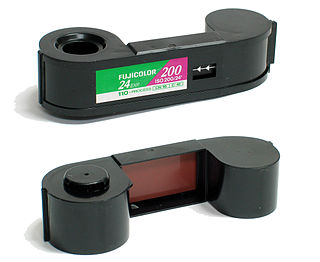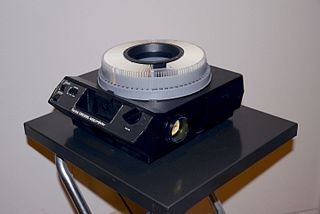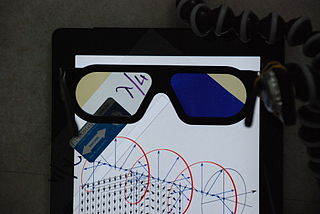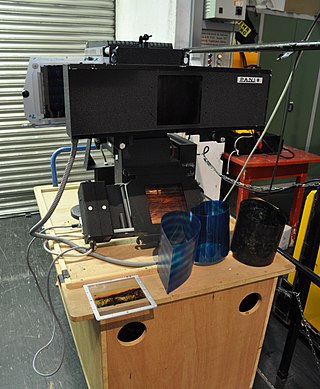
110 is a cartridge-based film format used in still photography. It was introduced by Kodak in 1972. 110 is essentially a miniaturized version of Kodak's earlier 126 film format. Each frame is 13 mm × 17 mm, with one registration hole. Cartridges with 12, 20, or 24 frames are available on-line. Production variations sometimes have allowed for an additional image.

Leica Camera AG is a German company that manufactures cameras, optical lenses, photographic lenses, binoculars, and rifle scopes. The company was founded by Ernst Leitz in 1869, in Wetzlar, Germany. The name Leica is derived from the first three letters of the founder's surname (Leitz) and the first two of the word camera: lei-ca.

An overhead projector, like a film or slide projector, uses light to project an enlarged image on a screen, allowing the view of a small document or picture to be shared with a large audience.

An LCD projector is a type of video projector for displaying video, images or computer data on a screen or other flat surface. It is a modern equivalent of the slide projector or overhead projector. To display images, LCD projectors typically send light from a metal-halide lamp through a prism or series of dichroic filters that separates light to three polysilicon panels – one each for the red, green and blue components of the video signal. As polarized light passes through the panels, individual pixels can be opened to allow light to pass or closed to block the light. The combination of open and closed pixels can produce a wide range of colors and shades in the projected image.

A video projector is an image projector that receives a video signal and projects the corresponding image onto a projection screen using a lens system. Video projectors use a very bright ultra-high-performance lamp, Xenon arc lamp, metal halide lamp, LED or solid state blue, RB, RGB or remote fiber-optic RGB lasers to provide the illumination required to project the image. Most modern projectors can correct any curves, blurriness and other inconsistencies through manual settings.

Minolta Co., Ltd. was a Japanese manufacturer of cameras, camera accessories, photocopiers, fax machines, and laser printers. Minolta Co., Ltd., which is also known simply as Minolta, was founded in Osaka, Japan, in 1928 as Nichi-Doku Shashinki Shōten. It made the first integrated autofocus 35 mm SLR camera system. In 1931, the company adopted its final name, an acronym for "Mechanism, Instruments, Optics, and Lenses by Tashima".

A movie projector is an opto-mechanical device for displaying motion picture film by projecting it onto a screen. Most of the optical and mechanical elements, except for the illumination and sound devices, are present in movie cameras. Modern movie projectors are specially built video projectors.

A carousel slide projector is a slide projector that uses a rotary tray to store slides, used to project slide photographs and to create slideshows. It was first patented on May 11, 1965, by David E. Hansen of Fairport, New York. Hansen was an industrial designer at the Eastman Kodak Company. A patent for the rotary tray was granted in 1966 after a 1962 application by the Eastman Kodak Company.

Praktica was a brand of camera manufactured by Pentacon in Dresden in eastern Germany, within the GDR between 1949 and the German reunification in 1990. The firm Pentacon was divided in mainly two parts and sold after German reunification. Schneider Kreuznach and Noble bought parts of it. Pentacon is a Dresden-based company in the optical and precision engineering industry, which was at times a major manufacturer of photo cameras. The name Pentacon is derived on the one hand from the Contax brand of the Dresden Zeiss Ikon Kamerawerke and Pentagon, because a pentaprism for SLR cameras developed for the first time in Dresden has this shape in cross section. Today's PENTACON GmbH Foto- und Feinwerktechnik is still based in Dresden. It is part of the Schneider Group, Bad Kreuznach. Pentacon is the modern-day successor to Dresden camera firms such as Zeiss Ikon; for many years Dresden was the world's largest producer of cameras. Previous brands of the predecessor firms included Praktica, Exa, Pentacon, Zeiss Ikon, Contax, Ica, Ernemann, Exakta, Praktiflex, and many more.

Rollei was a German manufacturer of optical instruments founded in 1920 by Paul Franke and Reinhold Heidecke in Braunschweig, Lower Saxony, and maker of the Rolleiflex and Rolleicord series of cameras. Later products included specialty and nostalgic type films for the photo hobbyist market.

Contax began as a German camera model in the Zeiss Ikon line in 1932, and later became a brand name. The early cameras were among the finest in the world, typically featuring high quality Zeiss interchangeable lenses. The final products under the Contax name were a line of 35 mm, medium format, and digital cameras engineered and manufactured by Japanese multinational Kyocera, and featuring modern Zeiss optics. In 2005, Kyocera announced that it would no longer produce Contax cameras. The rights to the brand are currently part of Carl Zeiss AG, but no Contax cameras are currently in production, and the brand is considered dormant.

Jos. Schneider Optische Werke GmbH is a manufacturer of industrial and photographic optics. The company was founded on 18 January 1913 by Joseph Schneider as Optische Anstalt Jos. Schneider & Co. at Bad Kreuznach in Germany. The company changed its name to Jos. Schneider & Co., Optische Werke, Kreuznach in 1922, and to the current Jos. Schneider Optische Werke GmbH in 1998.

A polarized 3D system uses polarization glasses to create the illusion of three-dimensional images by restricting the light that reaches each eye.

A planetarium projector, also known as a star projector, is a device used to project images of celestial objects onto the dome in a planetarium.
The Hektor is a photographic lens design manufactured by Leica Camera. The first "fast" lens available for the Leica I(A) was the Hektor 50mm f/2,5. Later, the design was adapted for use as a long portrait lens, available first in a 135mm f/4,5 screw-mount version and later in a 125mm f/2,5 bayonet-mount version. It is reported that Max Berek, who designed the original lens line for Leitz, named the "Hektor" after his dog.

Large-screen television technology developed rapidly in the late 1990s and 2000s. Prior to the development of thin-screen technologies, rear-projection television was standard for larger displays, and jumbotron, a non-projection video display technology, was used at stadiums and concerts. Various thin-screen technologies are being developed, but only liquid crystal display (LCD), plasma display (PDP) and Digital Light Processing (DLP) have been publicly released. Recent technologies like organic light-emitting diode (OLED) as well as not-yet-released technologies like surface-conduction electron-emitter display (SED) or field emission display (FED) are in development to supercede earlier flat-screen technologies in picture quality.

Pentacon is the company name of a camera manufacturer in Dresden, Germany.

A large-format slide projector is a kind of slide projector for large image projection which has a very powerful light source. The light source generates a lot of heat even when filtered to only visible light; the projected transparency is protected from overheating by the heat being distributed across its large size, and cooling fans. Slide formats include 18 × 18 cm or 24 × 24 cm.

A projector or image projector is an optical device that projects an image onto a surface, commonly a projection screen. Most projectors create an image by shining a light through a small transparent lens, but some newer types of projectors can project the image directly, by using lasers. A virtual retinal display, or retinal projector, is a projector that projects an image directly on the retina instead of using an external projection screen.
Iscorama was a trademark applied by ISCO Optics of Göttingen to a series of consumer-grade anamorphic lenses manufactured between the late 1960s and the beginning of the 21st century. These lenses were notable for their high optical quality and unique focusing characteristics, and with the advent of DSLR-based film making have attracted much interest from independent cinematographers and directors.





















